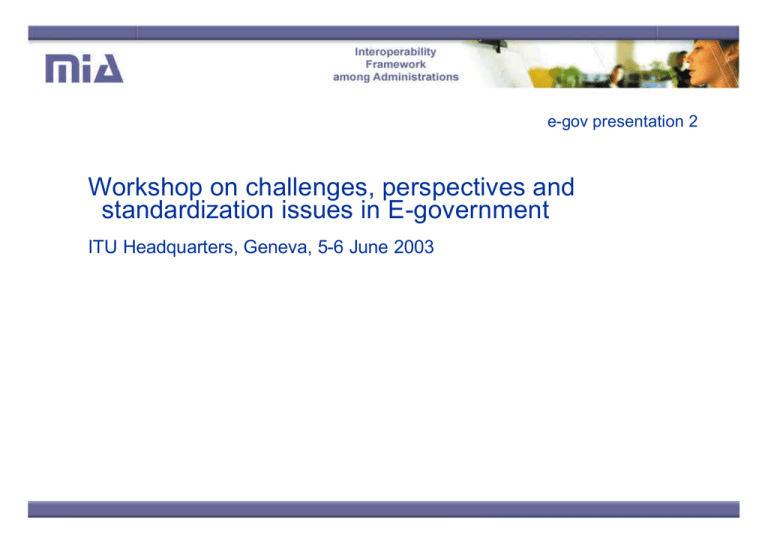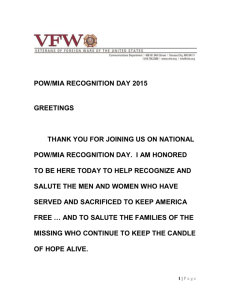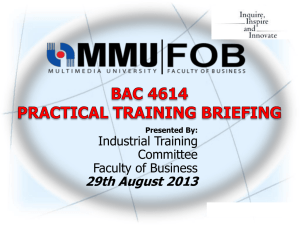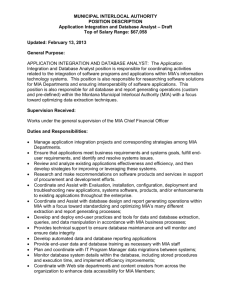Workshop on challenges, perspectives and standardization issues in E-government e-gov presentation 2
advertisement

e-gov presentation 2 Workshop on challenges, perspectives and standardization issues in E-government ITU Headquarters, Geneva, 5-6 June 2003 MIA overview Aljosa Pasic STREAM Technology Center Slide Summary 1) E-government and interoperability issues 2) MIA initiative: the vision and the objective 3) Consortium and members 4) Structure and methodology 5) Future work, conclusion and questions E-government interoperability • What is E? What is government? • Interoperability: what rockets and horses have in common? • Overview of international and national initiatives (IDA, SAGA, eGIF…) • From e-service to e-process steps • The interoperability today for the “seamless integration” of tomorrow Life event Service Process Process steps Enabling technology • Web service aggregation • WS Profiles and specification sets • Orchestration of transactions • Syntactic (format) and semantic (meaning) interoperability • Machine readable knowledge: ontologies, topic maps MIA vision and objectives • MIA history: from a conference to a project proposal • IST SmartGov cluster and FP5 Continuity (bottom-up approach) • + “real world” problems like legacy • + national initiatives, IDA (top-down approach) • + Territorial equilibrity with the accent on NAS • + research relations (network of excellence) • = impact on eGov in Europe and outside • = impact on standardisation and normalisation • = enable dynamic seamless service integration • = progress in semantic interoperability MIA vision and objectives The final objective MIA is to provide a layered specifications that enables interoperability in European Administrative Space through the use of formal definitions of interactions amongst public administration services and applications. This interaction is based on mechanisms for dynamically discovering services, service bundling, invocation and orchestration as well as exchange of XML documents and service catalogues. MIA consortium • MIA initative members: about 105 members • MIA IP members: about 70 interested partners • Main partners: SlbSema, Pouliadis, Barcelona Municipality, Pomeranian region, University of Linz, University of Cyprus, Intrasoft Intl., Univeristy of Southampton, European Dynamics, Universidad Politecnica de Valencia… • Ministries from France, Greece, Czech republic, Cyprus, Malta, Belgium, Portugal, Turkey… • Regions of Hampshire, Isle of Wight, Toscana, Lower Saxony, Plzen, Valencia… • Cities of Naestvaed, Gdansk, Barcelona… MIA management Steering board Scientific coordination Technical Board Project Management Office Vertical pilots Horizontal Pilots and demo. Attentive research Operational research Initiation: Identify Interoperability gaps Data federation and service catalogues Process invocation and coordination Service discovery and ad hoc architecture Service composition: Negotiation & contracting Planner List of Business Objects List of Business Processes List of Business Locations List of service providers List of goals & events Owner Semantic Model Business Process Model Business Logistics System Service platform Schedule, events and cycle Designer Logical Data Model Process Architecture Service Deployment Architecture Service interface design Rules & regulations Builder Federal (Physical) Data Model Distributed WF execution environment Distributed AI technology (Ontology Contract & based) Service negotiation composition environment Perspective MIA attentive research & technology transfer: share common views & good practises • Service support middleware: buses, Web services brokers, XML routers and Web services networks (e.g. IDA eLink project to develop/deploy information brokers) • Develop specifications compliant with known systems (SHS, OSCI, UK Gateway...) • “What” (domain expert groups”) and “how” (KM research organizations) to achieve semantic interoperability MIA operational research: transform eGov space • A holistic view on citizen- centric processes • Reference models, standards and guidelines • Redefine agency & process • Change management MIA horizontal groups: avoid reinventing the wheel • Security: service validation, access, identity… • Legal • Training • Dissemination • Reusable components (schemes, design…) depository MIA future actions • • • • Negotiation with the EC about the funding Extend contacts with the standardisation bodies Extend contacts with the national representation Improve internal organisation and formalise roles & responsibilities (signed commitment) MIA conclusions • Elaboration of guidelines for the selection, processing, presentation and archiving of information in the eGov domain systems • Improved Life Event (Business Situation) use case analysis through the usage of a five-view (planner, owner, designer, builder, citizen) service architecture. • Improve integration of existing services. • Improved development of new e-services. • Reduction of the cost of integration and maintenance. • Reduction of data distortion and error rate through the improvement of semantic integrity




